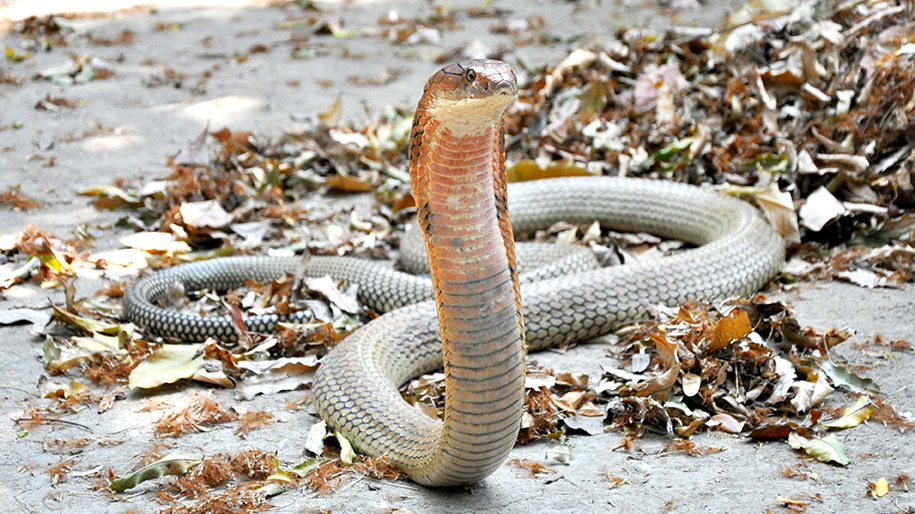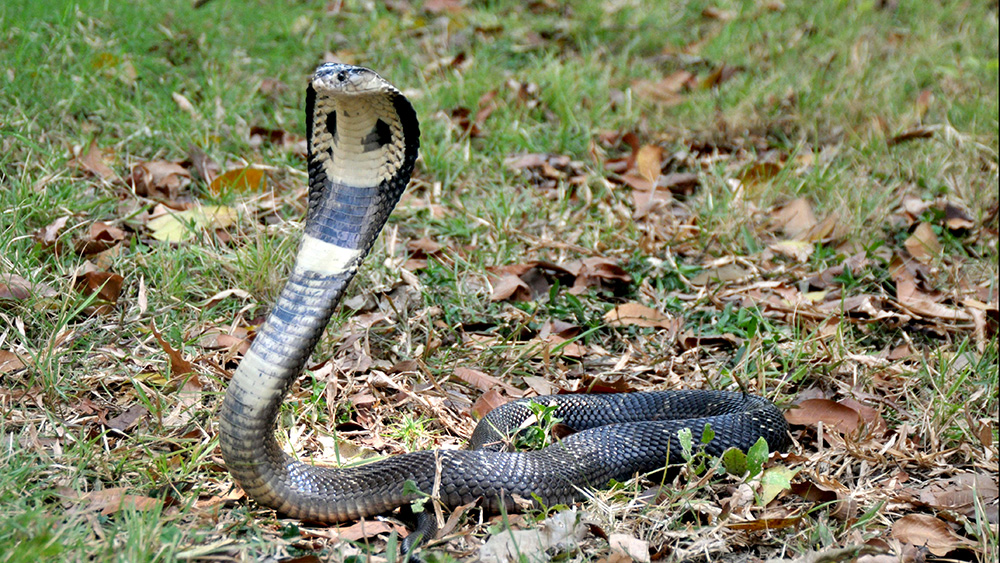
Snake Farm
Snake Farm
Snake Classification
Venomous Snake with medical importance in Thailand
King Cobra [Ophiophagus hannah (Cantor, 1836)
Size : 200 – 540 cm, averages 400 cm, record 585 cm.
Characteristics : Adults have high variation in color and pattern form uniform olive, brown, green or orange yellow with ring-like cross bands of black, while uniform dark gray to black individuals occur. If threatened; it will defend vigorously by rearing up the anterior third of its body and spread its neck. The hood is longer than that of Naja sp., but much more narrow and patternless. A pair of occipital scales is distinct. Newborns are black with yellow or light yellow bands across from snout, in front of and behind the eyes, encircle the body, and a yellow chevron on the neck. These yellow bands will be disappeared when aged about 6 months or 1 meter in length.
Breeding : In November to March. Oviparous, 12-51 eggs per clutch in January to May. Female excavates and remains near the nest to guard the eggs until hatched within 60-70 days of incubation in March to July. Hatchlings weigh 12-24 gm and 48-65 cm in length.
Food : Snakes, lizards.
Habitat : Dense jungle and plantation up to 2,135 meters, often near streams.
Range : Thailand, Myanmar, Laos, Cambodia, Vietnams, Malaysia, and Singapore.
Extralimital : India, Bangladesh, southern China, Indonesia, Philippines.
Siamese / Monocellate Cobra (Naja kaouthia Lesson, 1831)
Size : 100-180 cm, record 2.25 meters (QSMI data, 26 December 1995).
Characteristics : Typical Monocellate hood mark always presents on the back of neck, less frequently variation. Color is variable; medium to dark brown or gray-brown.
Breeding : In August to January. Female lays 15-37 eggs per clutch in October to March. Incubation period ranges 51-69 days (averages 60 days). Hatchlings weigh 13.2-18.8 gm and 31.5-35.5 cm in length.
Food : Small mammals, rodents, birds, frogs, toads and perhaps other snakes.
Habitat : Terrestrial and diurnal. Found in termite mounds, near human habitation, paddy fields, forests and foothills up to 900 meters.
Range : Thailand, Myanmar, Cambodia, Vietnam, northern peninsular Malaysia, southern Laos.
Extralimital : Bengal, northeastern India, Nepal, China.
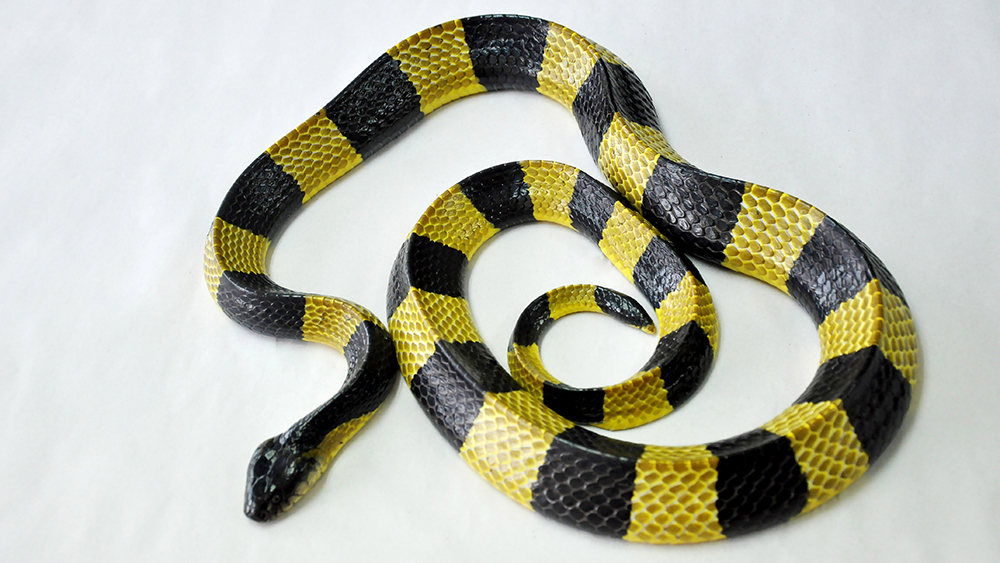
Banded Krait [Bungarus fasciatus (Schneider, 1801)
Size : 100-180 cm, up to 200 cm. Females is larger than males.
Characteristics : Body is stocky with distinct vertebral ridge. Head is predominantly black with yellow supralabials. Tip of tail is blunt. Color pattern is marked with alternate black and yellow bands of almost equal width encircle the body and tail.
Breeding : In January to March. Oviparous, 8-12 eggs per clutch in March to May and hatched in May to July. Hatchlings weigh 14.0-19.6 gm and 26.5-33.5 cm in length.
Food : Snakes, lizards and fishes.
Habitat : Common in lowlands, coastal regions such as mangrove forests and agricultural areas up to 2,300 meters.
Range : Throughout Thailand and Southeast Asia.
Extralimital : Bhutan, northeastern India, southern China including Hong Kong and Hainan.
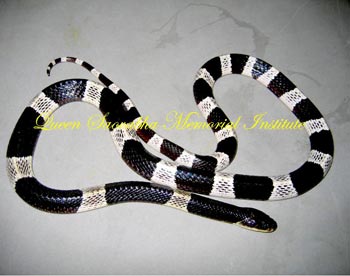
Malayan Krait [Bungarus candidus (Linnaeus, 1758)
Size : 100-150 cm.
Characteristics : Black and white bands alternates along the cylindrical body, white bands with black speckling in adults and black bands do not encircle body. Head is grey-black. Pointed tail.
Breeding : In December to January. Oviparous, 4-8 eggs per clutch in February to March and hatched in April to May. Hatchlings weigh 5-8 gm and 27-34 cm in length.
Food : Snakes, skinks, frogs.
Habitat : Found near human habitation, forested areas at elevations of 540-1,525 meters.
Range : Throughout Thailand, Laos, Vietnam, Cambodia, Malaysia.
Extralimital : Sumatra, Java, Bali and Sulawesi in Indonesia.
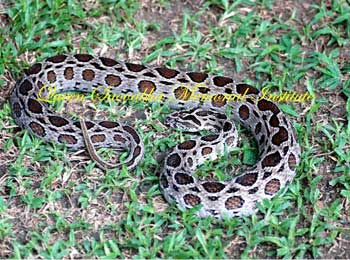
Russell’s Viper [Daboia russelii siamensis (Smith, 1917)
Size : 90-150 cm.
Characteristics : Body is stout, light brown background with a series of multicolor blotches. These blotches vary in shape and size, are dark brown with black inner and white outer edges. Head is distinctly triangular covered with small-keeled scales. When threatened, it coils tightly, continuous hisses, and strikes with such speed.
Breeding : In October to December. Ovoviviparous, 20-45 babies (max. 63 babies) per litter in March to April. Newborns weigh 7.2-14.4 gm and 24-30 cm in length.
Food : Rodents, birds, frogs.
Habitat : Termite mounds, paddy fields, found up to 2,000 meters.
Range : Common in the central of Thailand. The different subspecies found in Myanmar, Laos, southern China, Vietnam, Sri Lanka, India, Pakistan, Bangladesh, eastern Indonesia and Taiwan.
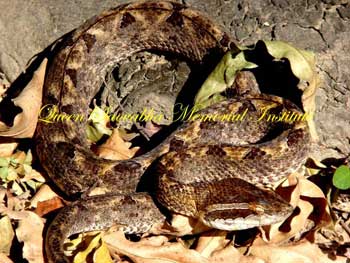
Malayan PitViper [Calloselasma rhodostoma (Boie in Boie, 1827)
Size : 50-80 cm, up to 100 cm. Females is larges than males.
Characteristics : Head is triangular covered with large symmetrical shields and a light stripe extends from the snout to each side of the mandible. Snout is pointed and turned up slightly at tip. Body is light to dark reddish or purplish-brown background with dark triangular marking. The base of triangular marking ends at the vertebrae.
Breeding : In March to May. Oviparous, 10-30 eggs per clutch in May to September, Egg incubation for 33-45 days and hatching in June to October. Hatchlings weigh 2.2-6.6 gm and 13.5-18.5 cm in length, tip of the tail is white.
Food : Rodents, frogs, toads, birds.
Habitat : Rubber plantations, humid forested lowlands, found up to 2,000 meters.
Range : Thailand, central and southern Laos, Cambodia, southern Vietnam, western Malaysia.
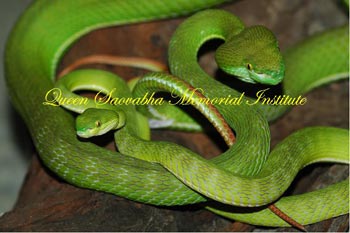
White-lipped Pitviper [Cryptelytrops albolabris (Gray, 1842)
Size : Males up to 70 cm, females up to 90 cm. Both sexes may slightly exceed one meter in length, adult females being larger.
Characteristics : Fairly stout body with keeled scales; long and roughly triangular head, covered with smooth small scales, that very distinct from neck. Head and dorsum are green; belly, supralabials, chin and throat are yellow, white or pale green. Male have a white strip on the first dorsal scale row which is distinct or absent on females. Prehensile tails are reddish-brown on both sexes.
Breeding : In September to November. Ovoviviparous, 7-30 per litter in February to May. Newborns average 20 cm in length and weight 3.6-5.2 gm
Food : Forages on mice, birds, lizards and frogs at night on the ground, in bushes and trees.
Habitat : Encountered near human habitation, open country below 400 m. of elevation and in urban areas.
Range : Throughout Thailand through Myanmar to Indochina, south through Indonesia.
Extralimital : Southern China, from Yunnan east to Guangdong and Hainan, north to Anhui; northern India and Nepal.
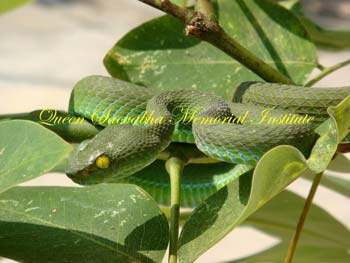
Big-eyed Pitviper [Cryptelytrops macrops (Kramer, 1977)
Size : 60-70 cm.
Characteristics : Fairly slender body. Head and dorsum are dark green or bluish-green; belly, mandible and chin are bluish-green. Stout and triangular head is very distinct from neck. Yellow eyes are large compare to other pitvipers.
Breeding : In September to November. Ovoviviparous, 5-12 litters per clutch in February to May.
Food : Mice, birds, lizards, frogs, toads. Forage at night on the ground, in bushes and trees.
Habitat : Encountered near human habitation, on trees near streams.
Range : Common in the central part of Thailand, Cambodia, Vietnam and southern Laos.
..................................................................
Common non-venomous snakes in Thailand
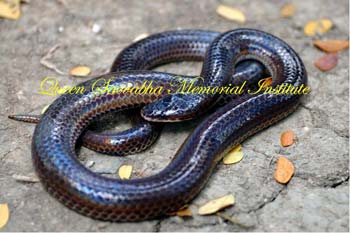
Sunbeam Snake [Xenopeltis unicolor (Boie, 1827)
Size : Up to 120 cm.
Characteristics : Dorsum is dark brown to black while belly is white. Flatten head with small eyes. Smooth scales and iridescence. Newborn is distinct with white collar around neck.
Breeding : I3-17 eggs per clutch, Incubation period of 19 eggs took 65 days for hatching in May (data of QSMI; Queen Saovabha Memorial Institute). Hatchlings weigh 8.2-8.6 gm and total length 25.0-29.5 cm.
Food : Nocturnal. Feed on snakes, mice, frogs and skinks.
Habitat : Semi-burrowing species in humid area.
Range : Throughout Thailand, Southeast Asia.
Extralimital : India.
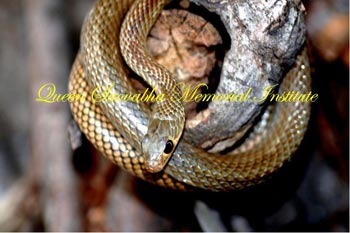
Indochinese Rat Snake [Ptyas korros (Schlegel, 1837)
Size : 100-256 cm.
Characteristics : Body is olive which progressive brown at posterior and tail. Smooth scales with black-edge along the body. Head is slender; grayish-brown in color with very large eyes.
Breeding : 4-12 eggs per clutch.
Food : Diurnal. Feed on mice, frogs and skinks.
Habitat : Agricultural areas or forest up to 3,000 m. of elevation.
Range : Throughout Thailand, Malaysia, Singapore, Bali in Indonesia.
Extralimital : Taiwan and Assump in India.
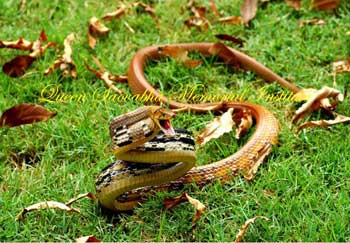
Copperhead Rat Snake [Coelognathus radiatus (Boie, 1827)
Size : 180-230 cm.
Characteristics : Body is yellowish or grayish-brown with 4 black stripes from neck to mid body. Head is reddish-brown with 3 black streaks radiating posterior to eyes. If threatened, it pretends dead to avoid enemies or expand throat longitudinally and rear up the anterior fourth of its body in S-shape and strike rapidly.
Breeding : In June to January or throughout the year. 5-12 eggs per clutch in December to July, hatching in February to September. Hatchlings weigh 11.0-12.4 gm and 44-46 cm in length.
Food : Diurnal. Feed on mice and birds..
Habitat : Lowland area or on trees.
Range : Throughout Thailand and Southeast Asia.
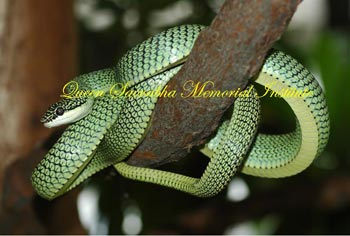
Ornate Gliding Snake [Chrysopelea ornata ornatissima (Werner, 1925)
Size : 100-130 cm.
Characteristics : Body is yellowish-green, smooth scales with dark edge or dark scales in crossing pattern along the body. Keels on both sides of ventral part assisted for climbing. This active snake can glide between canopies.
Breeding : 6-12 eggs per clutch. 15 eggs in March and hatched in May (QSMI data). Incubation period in laboratory 70 days.
Food : Diurnal. Feed on birds, mice, lizards, frogs and bats.
Habitat : AOn trees in low land area or hills up to 550 meters of elevation.
Range : Throughout Thailand, Myanmar, Malaysia.
Extralimital : India and southern China.
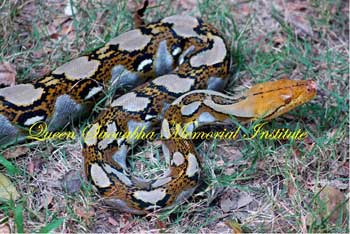
Reticulated Python [Python reticulatus (Schneider, 1801)
Size : 700-1,000 cm.
Characteristics : The stocky body with reticulated pattern of black and yellow stripes which surrounding white or brown blotches on both sides of vertebrae. Head is yellowish-brown to yellow with black streak from snout through neck and the other from eyes to angle of mandible. Smooth scales and iridescence.
Breeding : 30-50 eggs per clutch, up to 124 eggs in record. Incubation period is 68-72 days in laboratory. Hatchlings weigh 72-79 gm and 125-165 cm in length.
Food : Nocturnal. Feed on mammals, occasionally on human due to size and ability of constriction.
Habitat : Humid forest up to 1,500 m of elevation, near human habitation. Terrestrial but be good climber.
Range : Throughout Thailand, Malaysia, Singapore, Myanmar, Philippines and Forest archipelagos.
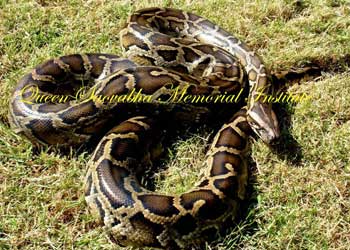
Burmese Python or Javanese Python [Python molurus bivittatus (Kuhl, 1820)
Size : 600-700 cm.
Characteristics : The stout body, pale brown to brown background with large dark brown blotches surrounded by black edge along the body. Triangular head has a pale yellowish-brown arrow-shaped on top. The ventral part is white.
Breeding : 30-50 eggs per clutch.
Food : Nocturnal. Feed on small to medium mammals.
Habitat : Lowland areas or forest up to 900 m of elevation.
Range : Throughout Thailand except in the south, Indonesia (Kalimantan, Java, Sumbawa and Sulawesi).

